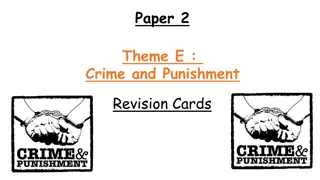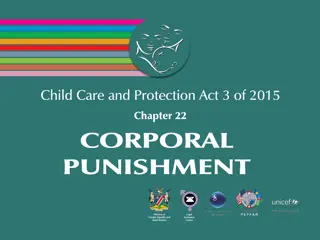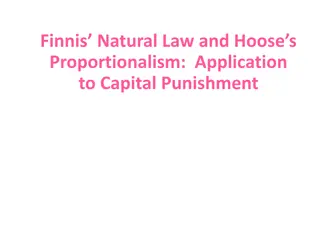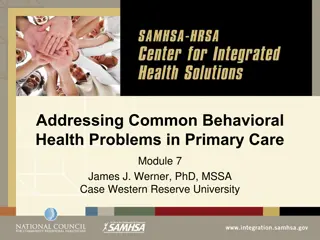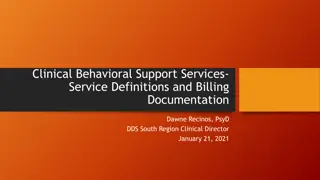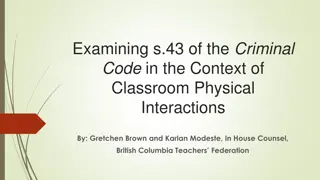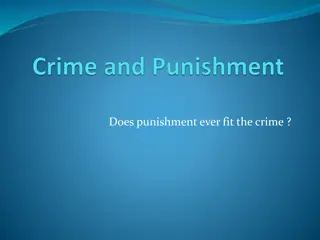Understanding Punishment and Learned Helplessness in Behavioral Science
Learning from the consequences that result in pain or discomfort is essential in shaping behavior. Punishment teaches individuals to avoid actions that lead to harm. Different types of punishment, positive and negative, affect behavior differently based on the presence or absence of certain stimuli. Aversive events play a role in both positive punishment and negative reinforcement. Understanding these principles is crucial in behavioral interventions.
Download Presentation

Please find below an Image/Link to download the presentation.
The content on the website is provided AS IS for your information and personal use only. It may not be sold, licensed, or shared on other websites without obtaining consent from the author. Download presentation by click this link. If you encounter any issues during the download, it is possible that the publisher has removed the file from their server.
E N D
Presentation Transcript
Punishment and Learned Helplessness
Lay Definition: Learning from the consequences that produce pain or discomfort. Definition of Punishment The loss of reinforcers: reaction to this has survival value for the individual and for the species. Punishment teaches us not to repeat responses that cause us harm
Punishment Effectiveness Punishing only reinforced response is often not an effective procedure. If you give organism an alternative, unpunished route to reinforcement, then effects of punishment are enhanced.
Punishment is defined neither by Nature of Punishment the actions of the person delivering the consequences nor by the nature of those consequences. A decrease in the future frequency of the occurrence of the behavior must be observed before a consequence qualifies as punishment.
Positive or Type I Punishment : Presentation of a stimulus (or an increase in the intensity of an already present stimulus) immediately following a behavior results in a decrease in the frequency of the behavior. Definitions of Punishment Negative or type II Punishment: Termination of an already present stimulus (or a decrease in the intensity of an already present stimulus) immediately following a behavior results in a decrease in the future frequency of the behavior.
Stimulus condition in the presence of which a response has a lower probability of occurrence than it does in its absence Discriminative Effects Response-contingent punishment: delivery in the presence of the stimulus. If punishment occurs only in some stimulus conditions and not in others: the suppressive effects of punishment will be most prevalent under those conditions
Note that aversive events are associated with positive punishment and with negative reinforcement (which is NOT punishment!) Also Term aversive control is often used to describe intervention involving either or both of these two principles. Known as Aversive Control This makes concepts confusing: Positive punishment: decreasing responding Negative reinforcement: increasing responding
Aversive but not contingent? Aversive stimuli can also affect operant behavior when that behavior neither produces nor prevents them When aversive stimuli occur independently of responding. Really classical conditioning to that stimulus Most famous example is conditioned emotional response (CER).
Rat must lever press to obtain food. Rat receives periodic pairings of tone with electric shock. Conditioned Emotional Response Rat eventually press lever at a lower rate when tone is on than when it is off. (CER) Phenomenon is called conditioned suppression or conditioned emotional response (CER; Estes & Skinner, 1941).
Is all we learned about positive reinforcement true, in mirror-image form, of punishment? Perhaps not. PUNISHMENT Any operant punishment situation is really a punishment plus reinforcement situation.
For punishment to suppress operant responding, responses must already be occurring with some frequency. For responses to occur, they must be producing reinforcement. Punishment + Reinforcement? So, effect of punishment reflects interaction of two contingencies-- reinforcement and punishment. Jointly operate in most situations.
As intensity of punishing stimulus increases, degree of suppression increases. Punishment Intensity: If very intense shock is used, then suppression may be virtually complete. (think about it!)
Suppressive effect of intermediate shock intensity depends on animal s past experience with shock. Role of past experience! If animal has experienced intensities going from mild to intermediate, then there will be little suppression. If animal has experienced intensities going from severe to intermediate, then there will be substantial suppression.
Immediate is Best! For punishment to be maximally effective, it must immediately follow operant response. As delay interval between response and punishment increases, amount of suppression decreases.
Should be certain (as close to 1.0 as possible) and follow each operant response. Probability of punishment should be 1.0 Probability of a punisher When responses are punished intermittently, effectiveness of punishment procedure is reduced. Is this different than what observe with reinforcement? Think about it!
When punishment is discontinued, suppressive effects on responding not permanent Recovery from Punishment: Extinction The rate of responding after punishment is discontinued will: Get immediate suppression effect then Not just recover But: Briefly exceed level at which it was occurring prior to punishment
Unconditioned punisher: stimulus whose presentation functions as punishment without having been paired with any other punishers. Innate Biologically relevant Still, all organisms not respond the same! Unconditioned Punishers Unconditioned punishers will suppress any behavior that precedes their onset. Again, is this similar to reinforcement?
Conditioned punisher is a stimulus change that functions as punishment as a result of a person s conditioning history. How are conditioned punishers different? Acquires capability to function as punisher through stimulus-stimulus pairing with one or more unconditioned or conditioned punishers. Examples?
If responses occurs in absence of punisher, the response will return, potentially, to pre- punishment levels Extinction of Conditioned punisher If the conditioned punisher is repeatedly presented without the punisher with which it was initially paired, effectiveness as punishment will diminish until it is no longer a punisher.
Generalized conditioned punisher: A stimulus that has been paired with numerous forms of unconditioned and conditioned punishers Generalization and Discrimination Discriminated punisher: A stimulus that has been paired with only one specific conditioned or unconditioned punisher becomes a. Examples?
Schedule or frequency of punishment Other factors influencing effectiveness of punishment: Availability of reinforcement for the target behavior Availability of reinforcement for an alternative behavior.
Punishment can result in death Grohmann, Dickomeit, Schmidt, & Kramer 2013 A 1-year-old, male intact, German shepherd dog presented to the emergency Vet clinic with incoordination and circling to the left was Four hours before presentation, the dog had been disciplined by the owner because of misbehavior during training. The dog was suspended a few feet in the air by its choke chain collar, a common form of punishment among dog handlers (Miller, 2008). By the owners reckoning, the action was terminated after approximately 60 seconds when the dog panicked and finally lost consciousness for a few seconds. At first, the dog appeared normal to the owner. During the next few hours, the dog became increasingly ataxic on all 4 limbs and was circling to the left.
Punishment can result in death The initial investigation of the referring veterinarian showed no abnormalities on general physical examination. For further evaluation of the neurological status, the dog was referred to veterinary school On presentation, the dog was anxious, panting, tachycardic (heart rate, 140 beats per minute), showing a body temperature of 40.0C, capillary refill time of 2 seconds, as well as dark pink and tacky mucous membranes. The neurological examination revealed severe disorientation, left-sided pleurothotonus, and circling. The hopping reaction was slightly reduced in all 4 limbs. As a sign of blindness, the menace response and the direct and indirect pupillary light reflexes were negative in both eyes. A bilateral mydriasis was present. The dog showed a variable nystagmus and a left-sided facial motor paralysis.
The neurological findings were consistent with a multifocal brain lesion. Differentials include diffuse axonal injury, vascular ischemia, increase in intracranial pressure, and hemorrhage. Punishment can result in death The results of the complete blood count and serum biochemistry were within the laboratory reference ranges. The dog was treated with a shock bolus (20 mL/kg for more than 20 minutes) of crystalloid intravenously, and after 30 minutes showed a physiological body temperature, normal heart rate, normal pink mucous membranes, and a capillary refill time of below 1.5 seconds.
An Magnetic resonance (MR) tomography was performed The T2-weighted scans showed a diffuse, nonhomogeneous, poorly demarcated hyperintense lesion within the dorsal and ventral aspect of the thalamus, both hippocampi, the lamina tecti of the midbrain and the splenal, suprasplenal,and marginal gyrus. The lesion was slightly more pronounced on the left side. A mild rostrotentorial herniation of the lamina tecti was noticed. In contrast to the rest of the brain, the thalamus, and could not be delineated. Punishment can result in death The ADC measures the magnitude of diffusion within the cerebral tissue. In the resultant ADC maps, this area appears hypo-intense compared with the diffusion weighted images. The presumptive diagnosis of a severe cerebral edema resulting from ischemia was made. As a result of the neurological findings and magnetic resonance imaging(MRI) findings, the owners chose to euthanize the dog.
Learned Helplessness
Four groups of dogs Four groups of dogs Training I and II Grp I Escapable/escapeable No lasting ill effects result run Learned Learned helplessness helplessness Marty Marty Seligman Seligman Grp II Inescapable/inescapable not run No lasting ill effects Grp III Escapable/inescapable not run No lasting ill effects Grp IV Inescapable/escapable not run Severe Remember, Seligman s hypothesis was that NONE of the dogs would be significantly harmed.
Key Factor = inescapability Once learned not to escape (learned to be helpless)= not change Characteristics of L.H. Inescapability that produces phenomenon, not the shock itself Works under variety of procedures, conditions Very generalizeable, transferable If take far enough, can make it a contingency rule for the animal, rather than specific contingency for specific situation(s)
Symptoms of L.H. Passivity Learned laziness Retardation of learning Somatic effects Reduction of helplessness with time
Clinical Expressions of Learned Helplessness School phobias and math anxiety Abusive Relationships Depression Cultural learned helplessness
Curing or eliminating learned helplessness Unlearn the rule Reshape or recondition Must be done in situation where organism cannot fail Difficult to do- animals can not respond UPenn program on relearning thoughts during test taking
Competing response hypothesis Dog learned motor responses which alleviated or attenuated shock Those were used in shuttle situation, but ineffective Thus learn the wrong responses Two theories to explain Adaptation hypothesis Organisms sensitive to independence of events Most situations: understand that shock is not dependent on their behavior In LH: not make this distinction, rather shock WAS dependent on their behavior
2 separate shock locations: harness or alley-way/shuttlebox Several procedures: Inescapable shock exposure instrumental escape/avoidance training Testing for chronic failure to escape Treatment of LH in dogs TREATMENT Removed barrier between sides Opened observation windows on opposite side of box Humans called dogs to safety side Forced escape/avoidance Recovery: testing again
YES! Learning contingency was critical Did it work? When learned that contingency was to escape- could overcome the first learning rule Was one of first attempts at treatment Why so important? One of first studies to suggest that you could be TAUGHT to overcome aversive events in your life!
Many of our foster, shelter and rescue dogs show symptoms of learned helplessness Why is learned helplessness important to dog training and our dogs? Misunderstanding their behavior for obstinacy, aggression, or other misbehavior will lead to worsening behavior Must understand that much of their misbehavior elicited due to LH
Over 15 million dogs turned out as strays or relinquished to shelters each year Small percentage are lost dogs Smaller percentage are homeless dogs Most are unwanted Reminder Relinquishment = stress Elicits stress hormones These, in turn, tied to aggression Soon aggression and stress become linked
Plasma levels of stress-related adrenal cortisol elevated in dogs at least during first 3 days in shelter Tied to anxiety, depression, etc. in dogs and humans AND a sign of developing LH In shelters: Tuber, et al., 1999 20-min of human contact reduced these levels to near normal
Brief contact of only 20 min had effect on cortisol Suggested less stressed after contact.
1977: Tuber and his colleagues began shelter interventions Treatment What did they find most productive in alleviating stress symptoms? Supportive environment
Living room: looks like a humans home living room Not a cage Most likely paired with good human-dog interactions Supportive Environment Living room provides place for Social interaction Behavioral assessment Training Make human interactions contingent on appropriate social behavior in dogs
Again, even brief contact significantly helped both puppies and older dogs.
Noncontingent interaction with humans was best Contingent interaction with toys was better VERY low latency to greet familiar person!
Non-Contingent attention Stroke-handling: touching all over; petting What kind of training works? Crate training and adaptation Safety issues for when adopted Make crate a safe and supportive place Introduction to noise, different people, etc.
Foster care In a living room 24/7 Get used to sights/sounds of living in a home Experience daily routines Morning, evening, staying home alone Learn changes in routines So, what about extending this? Varied experiences and introduction to many novel stimuli Development of generalization of social behavior Best simulation of where will go in adoptive home
Makes the dog adoptable! Accepts humans Acts appropriately when greeting looks like a normal dog Avoids development of learned helplessness Why is this socialization so important? Shelter considerations Makes shelters less aversive Not smelly or scary or full of aggressive dogs Foster homes communicate caring and well-being Avoids ove-rarousal, which increases chances of being adopted
Who should be involved in socialization efforts? Directors and direct-care staff Volunteers Everybody! Must be systematic training program Teach people the correct behavior to expect and demand from dogs Continuity and caring critical
What else important for adoption? Must remain in contact with adopter Check for any adjustment issues Offer behavioral/medical advice Give support Goal is to NOT have the dog return
Why isnt this done more systematically and in a more widespread manner? Time expensive Volunteer expensive Author suggests we use universities and psychology/biology/agricultur e departments!! Of course- why!!!!!?????


